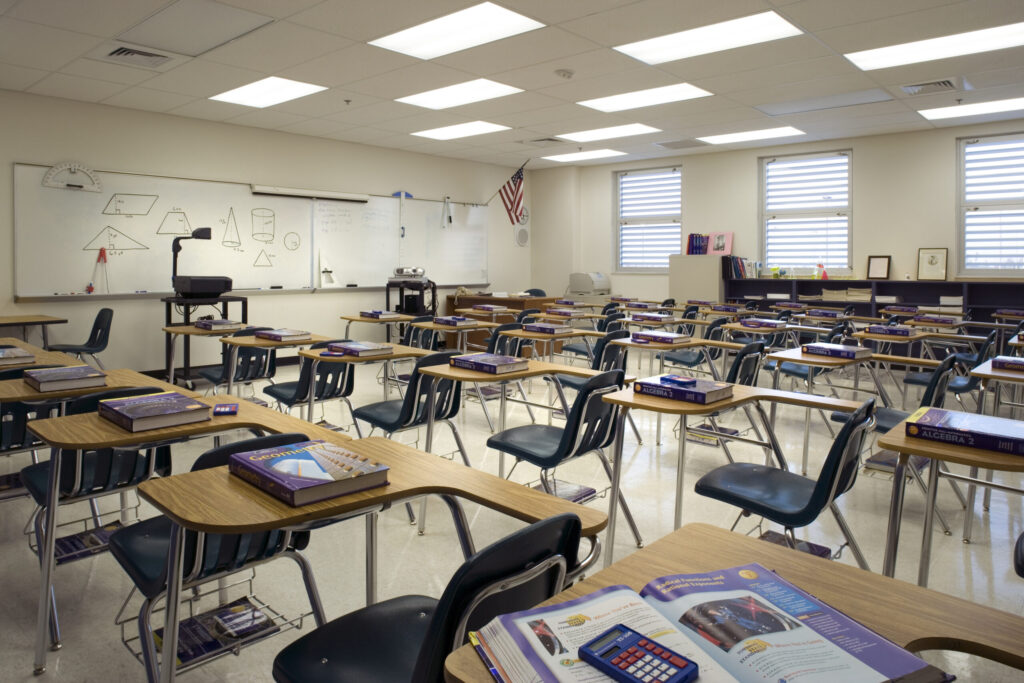An empty classroom. (Dan Forer/GettyImages)
With student absenteeism at record highs, more Washington districts are using a tool developed by researchers at Washington State University to help get kids back on track.
It’s called “WARNS” — or the Washington Assessment of the Risks and Needs of Students. About half of Washington’s districts will use the tool this school year: a projected 146 of the state’s 295 districts, up from 90 in 2019.
The 40-question, web-based assessment for middle and high school students is meant to help figure out why individual students are missing classes and what they need to stay in school.
“The idea is to try to get students interested in themselves,” said Brian French, regents professor at the Washington State University College of Education. French has been working on WARNS for about a decade, since the original version of the assessment was moved from the purview of the court system to Washington State University.
“It’s not meant to be a diagnostic tool,” French said. “It’s not meant to be a labeling tool. It’s really a tool that says: Let’s start a conversation with you.”
WARNS asks kids detailed questions about their relationships with their peers, mental health issues, family environment, school engagement and more. Once a student finishes the assessment, both the student and the school receive a set of scores indicating their risk level for different outcomes.
James Wise, assistant principal at Sunnyside High School in Yakima County, has been using the system for the past seven years and said WARNS helps districts get past basic questions like: “How was your day?”
“What the WARNS does is it has carefully crafted questions around lots of different areas of a kid’s life, and so we’re able to tease out the details without having a one-hour conversation with the kid that feels more like an interrogation,” Wise said.
Overwhelming research shows a connection between chronic absenteeism and worse student outcomes, but nearly a quarter of school districts surveyed nationwide by the Rand Corporation and the Center on Reinventing Public Education said their strategies to combat the issue haven’t been particularly effective.
French said he can’t directly link WARNS to a drop in absenteeism because there are so many other factors that can affect the issue. But one 2014 study of an eastern Washington school district, led by Paul Strand, a psychology professor at WSU who works with French on WARNS, found that when paired with “truancy reduction intervention,” WARNS helped increase graduation rates.
“The WARNS is an excellent tool,” Wise said. “But there’s nothing more important than having a relationship with the student and using the relationship to meet their needs.”
Washington has one of the highest absenteeism rates in the country, according to a recent analysis from the Associated Press and Stanford University educational economist Thomas Dee. That’s despite a state law called the Becca Bill requiring all children between 8 and 18 to attend school regularly.
There isn’t one reason why so many kids aren’t in school, said Strand, but he pointed to mental health, lack of affordable child care — which forces older kids to stay home and take care of their younger siblings — and access to transportation as some reasons they’ve seen in their work.
Children are also more likely to have higher risk scores on the WARNS if they’re facing other barriers, Strand said, like students with disabilities.
Some districts have found the assessment so useful, they’ve started using it for broader reasons, not just absenteeism. At Sunnyside, Wise said they use WARNS whenever a school social worker identifies a kid who needs additional support.
“The question really is about ‘How can we help this kid engage in school, not just attend?” Wise said. “And so if the kids get into fights, you want to figure out why. If the kid’s skipping, you want to figure out why.”
“If you can figure out the ‘why,’ you can help them overcome the situation they’re in. It didn’t make sense to only ask ‘why’ when it came to attendance. It makes sense to ask ‘why’ all over the place,” Wise said.
The WARNS team is using feedback from districts like Wise’s to improve the tool. Districts are asking them to consider highlighting student strengths, for example, to help motivate students and recognize what they’re good at. They’re also considering creating an assessment tool for the elementary level, which they say will have to involve parents.
Schools outside Washington have started using WARNS too, including in Minnesota, Virginia and Wisconsin. The WARNS team received a $1.4 million grant from the U.S. Department of Education in 2021 to help ramp up their operations.
“Our goal is to make it as easy as possible to have those helpful conversations with students,” French said. “I’m hoping our team in WARNS is making some kind of small progress on the situation in the state.”

